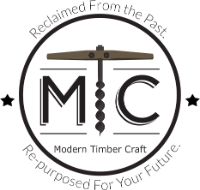Design experts routinely recommend different uses of reclaimed wood for their clients building new homes. From major construction components to fixtures, old-wood beauty, versatility, and charm add a unique flair to virtually any room.
While some installation projects work better with specific home designs, reclaimed wood offers unmatched durability, strength, texture, and color. Here are several uses of reclaimed wood for new homes.
Reclaimed Wood Flooring
Old wood can provide the look homeowners are seeking for flooring materials. Reclaimed wood is available in a remarkable number of species, colors, and sizes, so it is often the material of choice for flooring.
Reclaimed wood products often have hand-crafting marks and natural characteristics that make the floor appear as though it’s passed the test of time.

Homeowners seeking the distinct coloring of old-growth southern yellow pine can extend that color throughout a room or an entire level. If that pine variety is not locally available, there may be suppliers who can arrange shipping from another area.
Oak, maple, birch, and other wood species may also provide the flooring look you want. These wood species are available in widths and lengths to cover the largest rooms.
Reclaimed Wood Fireplace Mantels
Fireplaces are always popular and, these days, are typically adorned with a mantel shelf. New wood, stone, or concrete are all possible options as a mantel, but reclaimed wood gives the fireplace that old-world charm. Whether your new fireplace will be aesthetic or functional, a reclaimed wood mantel adds a final touch that’s bound to attract attention.

Like reclaimed wood flooring, fireplace mantel wood options are plentiful. For example, reclaimed wood that has been planed smooth is easier to handle but still adds timeless beauty.
Reclaimed Wood Kitchen Cabinets
Reclaimed wood kitchen cabinets and other built-ins remain popular, with distinct characteristics you can’t easily find with stock cabinets.

For a throwback appearance in your most popular room, you can get custom built reclaimed wood cabinets built with the following:
- Maple
- Oak
- Birch
- Cherry
- Hickory
- Pecan
- Walnut
Some species like cherry, hickory, pecan, and walnut are always in high demand yet scarce, so a reclaimed wood supplier may be an easier choice to find the wood species you want.
Reclaimed Wood Construction Elements
Reclaimed beams provide durability and appeal. Despite years supporting historic buildings, reclaimed beams can continue to be stalwarts for your new home. Whether exposed (preferred!) or hidden, reclaimed wood beams offer a recycled life to previously processed wood, which helps reduce impact on lost timber sources.

If you’re working with a local contractor and design team, ask about using reclaimed beams and any structural integrity risks for your new home.
Beams from old barns, factories, or other large buildings often contain scars they’ve earned over the years. Those imperfections create a foundational appearance that evokes history and sustainability all in one.
Reclaimed Wood Fixtures
Reclaimed wood is ideal for a wide variety of fixtures. For instance, accent walls featuring reclaimed wood add value and style to your home.
Looking for shelving? Reclaimed wood is ideal for bookcases or any other types of shelves needed throughout your new home.
Consider using reclaimed wood to build a statement table or center island for your kitchen.

A barn-style door is another option. Using reclaimed wood for the doors gives you an "organic" look that has weathered many years.
All these uses of reclaimed wood offer you creative options that can pay off in the long run. Your creations likely won’t be duplicated in other homes, and your home will have elements that can withstand the test of time.
To see more options, check out this post from Bob Vila's website.

Written by Jake Park
Jake is the founder of Modern Timber Craft and is a seasoned reclaimed woodworking enthusiast with over 20 years experience.


